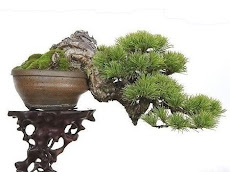Rapidly growing and responsive to training, you can quickly see the fruits of your labor when taking care of a Juniper Bonsai. This non-flowering and evergreen conifer have long, sprawling branches that can easily be styled to almost anything except the broom.
Considered as one of the most popular forms of bonsai, the Juniper has numerous varieties which include the Japanese Garden Junipers, Shimpaku, Chinese Junipers, Green Mound, just to name a few. Easy to manage, the Juniper can both grow indoors and outdoors, but it must be kept outside during winter for it to experience the dormant stage. By following this guide of proper care for Junipers, your tree will flourish and will not experience any difficulty while growing.
• Water your Juniper like most bonsai. Before watering your plant, check the soil by sticking your finger about half an each in the soil or if it is on a rock, lift it and feel the soil under it. If the soil is still moist, limit the amount of water that you'll pour on your bonsai to prevent root rotting. It is a general rule to never let you bonsai go dry for a long time. Although there are bonsai that prefer short dry periods, keeping your bonsai dry for extended periods will surely kill your plant. When watering your bonsai, allow the soil to absorb the water first before pouring another one. Eventually, you will soon be able to determine a schedule depending on the climate of your area.
• Your Juniper will need filtered sunlight. Avoid exposing your bonsai to direct sun.
• It is also important to use fertilizer on your Juniper. Use organic liquid fertilizer and feed your plant once every two weeks during spring and fall. A chemical fertilizer can also be used but it should be diluted. Follow the instructions given by the manufacturer.
• Your Juniper should be repotted every two years when it is still young or about 5-6 years old then every 3-5 years thereafter. Although it can be repotted in any time of the year, the best time is during spring or fall. After repotting place it in a cool and shady area and give liberal amounts of water until new roots appear.
• Provide it also with proper winter care by keeping it under cool temperatures usually under 600F to allow it to rest. Avoid exposing it to dry winds and extreme cold temperatures by using window wells, mulch beds or enclosed unheated rooms.
Following these instructions properly will help maintain your Juniper bonsai healthy and always beautiful. Read more about Juniper bonsai and have fun with your plant.
Article Directory: http://www.articlecube.com
Information on tree diseases can be found at the Tree Facts site.
Saturday, October 25, 2008
Taking Care Of Your Juniper Bonsai
Sunday, October 5, 2008
What Is Required For Indoor Bonsai Care?
Growing your own indoor bonsai plant is not too hard, once you understand the basic concept of the unique technique used to cultivate these trees. The aim of growing the bonsai tree is to recreate the appearance of a natural tree, in a miniature form.
The Indoor bonsai tree is slightly more difficult to grow than the outdoor type. Essentially, in their natural state, trees are grown outdoors. For this reason, when you are growing an indoor tree, there will be more challenges. To successfully grow the indoor bonsai tree, you must pay special attention to the tree’s environment, including soil, water and light.
There are a lot of different types of trees, and each one of these require their own type of unique care. Though there are many species of the plant, these trees can be placed into three categories. There is the tropical, the sub-tropical, and the temperate bonsai.
From these categories, the tree is then divided again into two sub-categories; those that lose their leaves during the fall and winter, and the indoor bonsai tree that keeps its leaves throughout the entire year.
One of the most important aspects to growing the indoor bonsai tree is light. You will need to ensure that your tree has adequate light at all times. An alternative to natural lighting for your indoor trees is fluorescent lighting. Fluorescent lighting does not give off heat like traditional lights do; therefore it will not dry out your tree.
When using artificial lighting, you will need to adjust the amount of time the lighting is turned on to simulate the natural changing of the seasons. For instance, in the fall you will want to reduce the amount of time the lighting is on, reducing it even more for winter. As spring and summer approaches, you will again, gradually increase the time the lighting is on.
Other important considerations of growing the indoor bonsai tree include, paying attention to the type of soil that you use, as well as watering, and pruning. If you plant your tree in fertile soil, you will likely not have to add additional fertilizer for three or four weeks. Watering should be done according to the type of plant that you are growing, but generally, you will want to keep the tree fairly moist through the spring and summer, but can slightly reduce the water during the fall and winter months.
Before you attempt to grow your own indoor bonsai tree, learn as much as you can about the type of tree you intend to grow. If you start out knowing what you need to do to be successful, your chances of growing the perfect bonsai tree will be much better.
Article Directory: http://www.articlecube.com
Enjoy awesome Indoor Bonsai info and awesome Bonzai info.
Enjoy



